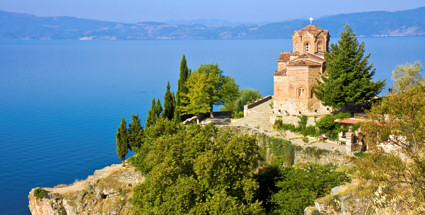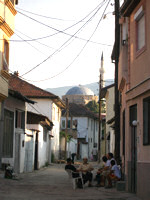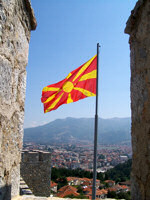Macedonia Revealed

Sveti Jovan Church overlooking Macedonia's Lake Ohrid
iStockphoto / Thinkstock
Despite emerging from the disintegration of Tito’s Yugoslavia in 1991, Macedonia is still relatively unknown in comparison to its Balkan neighbours but has plenty to offer tourists.
Bordered by Serbia, Albania, Bulgaria and Greece, this landlocked, multi-ethnic country boasts stunning mountains and dramatic scenery - a haven for walkers, climbers, skiers and other outdoor pursuits.
History buffs will not be left disappointed either. With a heritage intertwined with ancient Greece and Rome as well as 500 years of Ottoman rule, Macedonia’s undiscovered treasures are in the process of being unlocked - an increasing amount of archaeological digs are revealing significant findings in this fascinating country.
Skopje
Macedonia’s capital Skopje experienced a devastating earthquake in 1963 that destroyed much of the city’s beautiful 18th and 19th century buildings. The city that was rebuilt resulted in a concrete landscape that many associate with former communist countries.
Visitors to Skopje this summer would have been disappointed to see much of the city centre buildings obscured by scaffolding due to extensive rebuilding programmes.
However, although not renowned for its beauty, a toe dip past the surface reveals Skopje to be a fascinating destination with plenty of culture and hospitality. The cityscape is an assortment of apartment-blocks, mosque minarets and Orthodox churches, set against a mountainous backdrop: buildings indicative of the historical legacy of co-existing and conflicting cultures.
 Skopje's Turkish quarter
Skopje's Turkish quarterSashwati Mira Sengupta
Spread along the banks of the River Vardar, visitors have to head to the north side to glimpse the old Turkish side of town, Carsija. Here, cobbled streets are filled with bazaars and shops selling anything from glitzy evening wear to assortments of trainers and flashy jewellery. These bustling lanes are a good location for eating and drinking, with many restaurants serving mouth watering Turkish dishes.
Carsija’s skyline is dominated by the 10th Century Kale Fortress. The site itself dates back to the 6th century, but the present fort is a combination of early ruins dating from 600 years ago. The view of Skopje and the River Vardar from the fortress are impressive.
A walk downhill from Carsija will direct you to Kamen Most, the 15th century stone bridge leading to Makedonika Polstad Square on the south side of the river. Marsal Tito is a good spot for lounging in pavement cafes and bars or shopping in chi-chi boutiques.
Music plays an integral part of Macedonia’s rich culture, strongly influenced by the country’s sizeable Roma communities. Suto Orizari on the edge of Skopje, also known as Shutka, is the largest Roma settlement in the world, and Europe’s first self-governing Roma settlement. This is more a place of interest for Roma-culture enthusiasts rather than a genuine tourist attraction.
The market has a reputation as one of the best places to grab a bargain in the Balkans, and if you are a fan of Roma music then this is a great place to find CDs of local musicians from street vendors. There are functional parks and local recreational spots in the area rather than places of conventional beauty. The architecture is a multi-coloured jigsaw of anything from rundown shacks to more elaborate, wealthier homes.
If you visit in the summer, it is possible you will witness breathtaking wedding parties spilling out on to the streets. It is difficult to not be overcome by the warmth and charm of the local people, and many cite their visit to this deprived and transforming area as a highlight of their trip to Macedonia.
Mavrovo National Park
Just an hour’s drive out of Skopje lies Mavrovo National Park. The dramatic scenery and wildlife of this nature reserve makes this an alluring location for hiking, water-sports and skiing in the Zare Lazarevski resort.
Galicnik Svabda, the famous wedding festival of Galicnik village, is held every July. Couples compete to be selected for the special honour of marriage in the traditional Galichka style. The teskoto dance is a key element of the festivities: men in traditional dress clasp hands, and rise and fall to the majestic sound of drums and horns. The dance has a solemn tone, which symbolises the historic suffering of the population. This is a wonderful opportunity to view processions of local men and women in Macedonian dress.
Ohrid
Three hours south of Skopje, the town of Ohrid is the most cherished of Macedonian towns and a designated UNESCO World Heritage site. The town rests on the edge of Lake Ohrid, which dates back four million years and is one of the world’s oldest lakes. Its waters are said to be amongst the clearest and purest in Europe. Catching a ride on a boat-taxi provides serene views of Ohrid and Albania across the water.
 View from Fort Samul
View from Fort SamulSashwati Mira Sengupta
Ohrid itself has the character of a seaside town with fairground rides, restaurants and water sports. But it is also bursting with history and is home to The National Museum. The museum houses antiques and archaeological treasures from pre-history to modern-day. The Roman amphitheatre, sometimes used as an atmospheric concert venue, is worth a visit on the way up to Fort Samul which boasts spectacular views of the town.
Ohrid is said to be surrounded by 365 churches – one for each day of the year. Steep climbs up the mountainsides will take you to monasteries and churches, such as the 15th century Sveti Jovan. If that’s not your cup of tea, there is always the town’s lively party scene: Kaneo Beach has an air of the French Riviera with its glamorous bikini-clad crowd.
There is plenty of accommodation in the town and around the lake from campsites to modern hotels. Many visitors choose to stay in one of the numerous apartments, which are simple to find if you arrive with a suitcase or rucksack as you will most likely be approached in the street with an offer of cheap accommodation. Lakeside camping in the summer offers the chance for star-gazing on clear nights.
The pace of life is laid back and residents are always happy to engage with visitors on subjects such as the politics and history of Macedonia. You may well find yourself discussing the controversial debate surrounding the name of the country - Greece, Albania and Bulgaria all stake claim to the name ‘Macedonia’ as the present-day country was only one part of geographical and historical Macedonia. Internationally it is referred to as the ‘Former Yugoslavian Republic of Macedonia’ (FYROM).
Bitola
Bitola is a historic city with a dignified ambience, located at the foot of the Baba Mountain. It was previously the administrative and economic hub of Macedonia. Its political importance lent it the name of ‘City of Consuls’ in Ottoman times reflecting the many consulates once located there.
Architectural highlights include the famous Clock Tower as well as numerous mosques and churches. The nearby Pelister ski resort is another big draw in winter.
Do you have any Feedback about this page?
© 2025 Columbus Travel Media Ltd. All rights reserved. No part of this site may be reproduced without our written permission, click here for information on Columbus Content Solutions.









 You know where
You know where